general wellbeing

free shipping over $100 (USA & Canada)
1-877-937-4372 the pet expert hotline
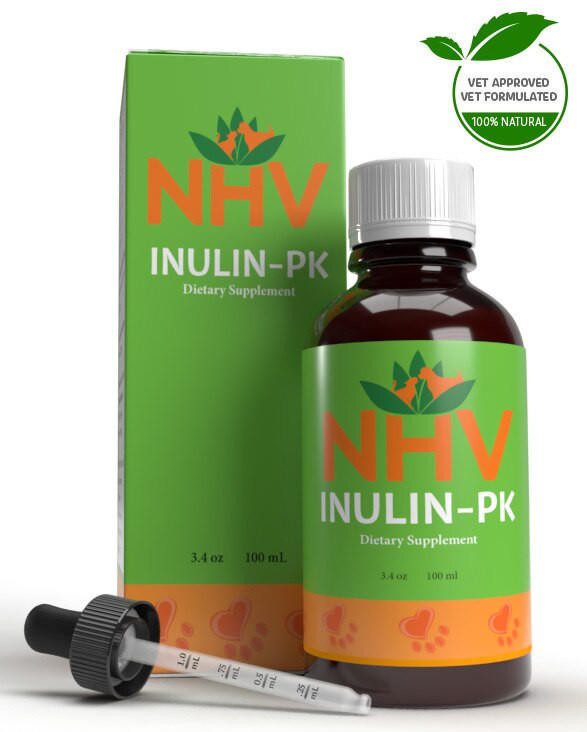

Bringing a rescue puppy home is an exciting and rewarding experience that can change your life and theirs, both for the better. Not only are you giving a loving dog a second chance, but you’re also welcoming a loyal companion into your family. The journey of adoption is filled with joy, responsibility, and the opportunity to create a lifelong bond.
Here’s how to make the transition as smooth as possible for you and your new furry friend.
Before bringing a rescue puppy home, it’s essential to prepare your living space to ensure their safety and comfort. Here are some tips for puppy-proofing your home:
The first day with your rescue puppy is a crucial time for establishing a sense of security. Here’s how to make their introduction to your home as smooth as possible:

It will be very tempting to greet your newly adopted dog with enthusiasm and affection when you pick it up and bring it home (or when it is delivered). However, this is NOT the time for that… at least not just yet! Since you are about to remove the animal from a familiar environment and take them to a new one, maintaining calmness and providing clear guidance is essential to set the tone and establish a positive relationship.
It’s important to continue that same calm energy you display during the initial meeting for the next three months and beyond. This doesn’t mean there can’t be moments of excitement or love, but overall, that calm demeanor should be present at all other times!
Once you arrive home, keep your dog on a leash and take them for a long stroll around the neighborhood. The purpose of this walk is to release excess energy and help them acclimate to the house without being overly energetic; set the initial boundaries of the relationship, including how to walk properly and how to listen; and familiarize your rescue dog with their new surroundings, including the various smells, sights, and sounds from different dogs and families in the neighborhood.
After your walk, when your dog is more relaxed, it’s time to bring them into the house! At this moment, do NOT remove the leash. We still want them to follow us, and we don’t want to let them sniff or roam freely. Allowing them to explore immediately sends the wrong message about leadership. Use the leash to keep them close, and guide them slowly from room to room. Spend a few minutes in each area, ensuring YOU enter and exit first. Every new space is an opportunity to assert leadership and train them to follow your lead! Once the tour of your home is complete, feel free to repeat the process if you have a backyard, patio, or other outdoor areas.
Continue the tour around your home while trying to ignore your dog. Petting, making eye contact, and talking are not advised, as your dog is already highly stimulated. In this new environment with unfamiliar people, minimizing stimulation will aid the integration process. By remaining quiet, and calm, and gently leading them into each room, you will reinforce your leadership and help the dog focus on you.
Once the tour is finished, it’s time to set some basic boundaries for your new dog! Continue to guide them on a leash to their feeding area, where you can offer some water and a few pieces of food (or treats). This helps create the boundaries for mealtime and establishes an area your dog can recognize.
After introducing the feeding area, take your dog to their sleeping space.
After introducing the feeding area, take your dog to their sleeping space. If you have a crate, start by introducing it and allowing your dog to explore. This could mean sniffing, walking around, or just being curious. Feel free to open the crate and toss in some treats or a chew toy. Your new dog might happily enter after them! If they settle inside, you can remove the leash and close the door, giving them time to relax. If they seem anxious, you can leave the door open for them to come and go as they please. The best way to acclimate them to a crate—if they’re unfamiliar with it—is to feed them in it, add something cozy, and fill it with treats!
If you decide not to use a crate, now is the time to let your dog off the leash and explore the area. By releasing them, you’re clearly communicating that this space belongs to them! If they immediately lie down or ignore the family, don’t worry! This means you’ve done the process correctly, and they feel comfortable within the pack!
At this stage, your dog should now be familiar with the layout of the house and the established boundaries. I encourage you to limit their freedom during the first few days by shutting doors and/or keeping some rooms off-limits! Additionally, continue to promote a calm environment for your dog by not overwhelming them with attention and affection. You can acknowledge them if they seek interaction, but try not to shower them with love just yet! While it may be tempting, giving your dog too much affection at this stage could later lead to separation anxiety when you’re not around.
During this critical period, your rescued dog is still adjusting to their new home, so it’s essential to remain calm to teach them that this is YOUR territory and YOU set the rules. By using your affection as a reward when they do something positive, you will send a strong message that resonates with them in the language of dogs during the first three days!
Building a strong bond with your rescue puppy is essential for their development and your relationship. This is going to pay huge dividends, as being able to mark, reward, reinforce, and correct your dog is crucial. One of the most important ways to nurture connection between you and your new puppy is by setting up a routine.
Over the first three days, your dog may not eat or drink much, may act funny, and will still be getting used to the environmental change. At this time, it is crucial to establish a daily routine so your dog can learn good behaviors. If you keep your routine consistent, you allow your dog to understand what is coming next in the day, and therefore reduce anxiety and stress. Here is an example of the daily routine we follow at our facility:
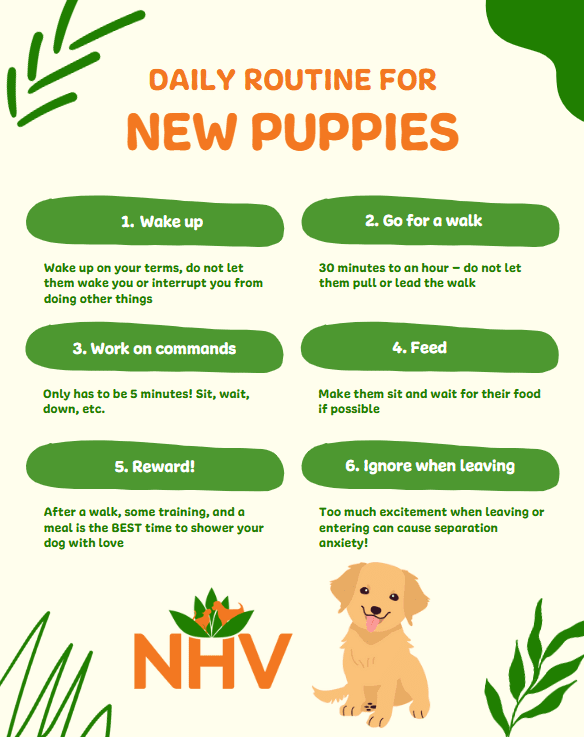
Additionally, if you come home from work and they are standing at the door, jumping, and/or super excited to see you – IGNORE THEM! If you acknowledge them and give affection at this point, you are positively reinforcing all the wrong behaviors, as well as creating an opportunity for separation anxiety to manifest later down the road.
By following these steps, you give your dog the greatest chance to succeed and decompress in its new environment. This process takes time, but by following this advice you mitigate a lot of the issues that can arise when adopting a rescue dog to be your new furry friend.
As your rescue puppy settles into their new home, consider incorporating NHV supplements to support their health and development when they are 4 months old or they are fully vaccinated.
These natural supplements can get your pup off to the right start:
Consult with NHV vet experts to find the right supplements tailored to your puppy’s needs.
The journey of bringing a rescue puppy home is filled with learning opportunities. During your puppy’s first three months of life, they’ll experience a socialization period that will permanently shape their future personality and how they’ll react to their environment as an adult dog. Gently exposing them to a wide variety of people, places, and situations can make a huge, permanent difference in their temperament. Here are some resources to support you as a new puppy parent:
Bringing a rescue puppy home is not just about adopting a pet; it’s about opening your heart and home to a new family member. With preparation, love, and patience, you’ll create a nurturing environment that allows your puppy to thrive and become a beloved part of your life. Enjoy every moment of this beautiful journey!
general wellbeing

Newly adopted pets are often quite stressed. They have spent time in the shelter, removed from their previous home or even from time roaming the streets. Though they are happy to have found a forever home, all of these changes can be quite stressful and can cause some undesirable behaviors. Matricalm is an all-natural supplement designed to reduce anxiety, stress and undesirable behaviors in pets.
Newly adopted pets can often use nutritional support. Whether they are malnourished from being stray, not eating because of stress in the shelter or just adjusting to their new home, Multi Essentials can help to fill nutritional voids. This all-natural herbal multivitamin that can help to support your pet's health throughout their life.
Stress and anxiety can cause gastrointestinal upset. Plantaeris can help to soothe and relieve spasms of the digestive tract which may cause diarrhea. It works quickly and gently to help promote normal bowel function.
bundle and save with pet expert kits
3 month supply for a small to medium size
Newly adopted pets are often quite stressed. They have spent time in the shelter, removed from their previous home or even from time roaming the streets. This can lead to undesirable behavior and decreased appetite as they adjust to their new home. This blend of supplements can help your new pet's transition into their forever home be as stress-free and seamless as possible.

Newly adopted pets are often quite stressed. They have spent time in the shelter, removed from their previous home or even from time roaming the streets. This can lead to undesirable behavior and decreased appetite as they adjust to their new home. This blend of supplements can help your new pet's transition into their forever home be as stress-free and seamless as possible.
MATRICALM
Chamomile – Contains sedative properties.
Passion Flower – An effective, non-addictive sedative.
Lemon Balm – An aromatic herb used for nervous disorders, excitability, and anxiety.
Valerian – Stops heart palpitations, relaxes spasms, relieves discomfort, and regulates the nervous system.
Hops – Eases tension and anxiety in pets.
MULTI ESSENTIALS
Alfalfa – Contains high protein levels (50%), vitamins, amino acids, minerals, sugars, and other nutrients.
Oat – Contains gluten, vitamins, and minerals (Ca, P, Mn, Cu, Zn, Fe).
Dandelion– A highly nutritious food that stimulates liver secretions, improves digestion, and stimulates the appetite.
Kelp – Rich in macrominerals (Ca, K, Mg) and trace minerals.
Parsley – Contains protein (up to 22%), vitamins (A, C, B1, B2, K), and minerals (Ca, K, Fe, Mg, P).
Marshmallow – Contains high levels of Ca.
Chickweed – A highly nutritious digestive tonic.
Stinging Nettle – Contains vitamins, minerals, and other nutrients.
PLANTAERIS
Barberry – Treats inflammation and infections of the urinary tract.
Mullein – Soothes and lubricates tissues.
Bayberry – Contains tannins, resins, and gums that control bacterial infection.
Myrrh – Relieves spasms, inflammation, and digestive discomfort.
Thyme – Improves digestion and relaxes spasms.
Chamomile – Relaxes the digestive system.
Chinese Peony – Reduces inflammation and relaxes spasms.
Ginger – Relieves discomfort and stimulates circulation.
Oregon Grape – Helps relieve indigestion and malabsorption.
To be taken twice daily. (Each supplement) Determine your pet’s weight and then use the easy chart below to determine the correct dose. This is the minimum dosage.
Pet's Weight Dosage
0 - 15 lb = 0.5 ml
16 - 30 lb = 1.0 ml
31 - 45 lb = 1.5 ml
46 - 60 lb = 2.0 ml
61 - 75 lb = 2.5 ml
Over 75 lb = 3.0 ml
For small animals (rabbits, ferrets), avians and reptiles use 1 drop for every 2 lb of body weight.
Long term use: Feed recommended dosage every other day (1 day on 1 day off). If used in large dosages or over a long period of time it may become irritating to the stomach lining. Some pets may require a larger dosage due to their metabolism. You can safely double the recommended dosage.
How to Administer: Shake well before use. The easiest method is to use the dropper provided and place the drops into your pet’s food or favorite treat. You can also use the dropper and squirt directly into the pet’s mouth. Some pets can be finicky, if this occurs consider hiding the drops in foods most pet’s love such as fish, chicken or yogurt or a favourite treat. If your pet only eats dry food then soak a few kibbles at feeding time.
For Best Results: Herbal dietary supplements are beneficial to the health and well-being of your pet and are safe for long-term use. Every pet responds to natural herbal supplements differently, therefore it is important to be consistent and administer the product daily. Supplements generally take two to four weeks to take effect, however this will vary from one animal to the next.
Product Storage: All NHV Natural Pet Products are pure herbal extracts and contain no artificial additives, preservatives or coloring. Shelf life after opening is 6 months and must be refrigerated after opening.
Cautions and Contraindications: Do not use Yucca in pregnant or nursing animals. Allowing breaks in feeding helps alleviate the possibility of a irritating effect on the digestive tract. Speak to your vet before using our products. A second visit is recommended if your pet’s condition does not improve, or deteriorates after continued use of the supplements. All information provided by NHV Natural Pet Products is for educational purposes only.
Select your pet's weight to determine the correct dose.
This kit can absolutely help. The supplements were chosen for their support for anxiety.
This kit can help to support anxiety, nutrition and GI troubles. They are all safe to give if your pet has other conditions. Seek veterinary advice if you suspect your pet is unwell
Even if pets are over-all healthy, their bodies can be affected by stress. This kit would be a great way to keep your pet stress free and healthy when brought in to a new home
We recommend using this kit until your new pet happily settles into your home, generally we would expect for about 3 months.
MATRICALM
Chamomile – Contains sedative properties.
Passion Flower – An effective, non-addictive sedative.
Lemon Balm – An aromatic herb used for nervous disorders, excitability, and anxiety.
Valerian – Stops heart palpitations, relaxes spasms, relieves discomfort, and regulates the nervous system.
Hops – Eases tension and anxiety in pets.
MULTI ESSENTIALS
Alfalfa – Contains high protein levels (50%), vitamins, amino acids, minerals, sugars, and other nutrients.
Oat – Contains gluten, vitamins, and minerals (Ca, P, Mn, Cu, Zn, Fe).
Dandelion– A highly nutritious food that stimulates liver secretions, improves digestion, and stimulates the appetite.
Kelp – Rich in macrominerals (Ca, K, Mg) and trace minerals.
Parsley – Contains protein (up to 22%), vitamins (A, C, B1, B2, K), and minerals (Ca, K, Fe, Mg, P).
Marshmallow – Contains high levels of Ca.
Chickweed – A highly nutritious digestive tonic.
Stinging Nettle – Contains vitamins, minerals, and other nutrients.
PLANTAERIS
Barberry – Treats inflammation and infections of the urinary tract.
Mullein – Soothes and lubricates tissues.
Bayberry – Contains tannins, resins, and gums that control bacterial infection.
Myrrh – Relieves spasms, inflammation, and digestive discomfort.
Thyme – Improves digestion and relaxes spasms.
Chamomile – Relaxes the digestive system.
Chinese Peony – Reduces inflammation and relaxes spasms.
Ginger – Relieves discomfort and stimulates circulation.
Oregon Grape – Helps relieve indigestion and malabsorption.
To be taken twice daily. (Each supplement) Determine your pet’s weight and then use the easy chart below to determine the correct dose. This is the minimum dosage.
Pet's Weight Dosage
0 - 15 lb = 0.5 ml
16 - 30 lb = 1.0 ml
31 - 45 lb = 1.5 ml
46 - 60 lb = 2.0 ml
61 - 75 lb = 2.5 ml
Over 75 lb = 3.0 ml
For small animals (rabbits, ferrets), avians and reptiles use 1 drop for every 2 lb of body weight.
Long term use: Feed recommended dosage every other day (1 day on 1 day off). If used in large dosages or over a long period of time it may become irritating to the stomach lining. Some pets may require a larger dosage due to their metabolism. You can safely double the recommended dosage.
How to Administer: Shake well before use. The easiest method is to use the dropper provided and place the drops into your pet’s food or favorite treat. You can also use the dropper and squirt directly into the pet’s mouth. Some pets can be finicky, if this occurs consider hiding the drops in foods most pet’s love such as fish, chicken or yogurt or a favourite treat. If your pet only eats dry food then soak a few kibbles at feeding time.
For Best Results: Herbal dietary supplements are beneficial to the health and well-being of your pet and are safe for long-term use. Every pet responds to natural herbal supplements differently, therefore it is important to be consistent and administer the product daily. Supplements generally take two to four weeks to take effect, however this will vary from one animal to the next.
Product Storage: All NHV Natural Pet Products are pure herbal extracts and contain no artificial additives, preservatives or coloring. Shelf life after opening is 6 months and must be refrigerated after opening.
Cautions and Contraindications: Do not use Yucca in pregnant or nursing animals. Allowing breaks in feeding helps alleviate the possibility of a irritating effect on the digestive tract. Speak to your vet before using our products. A second visit is recommended if your pet’s condition does not improve, or deteriorates after continued use of the supplements. All information provided by NHV Natural Pet Products is for educational purposes only.
Select your pet's weight to determine the correct dose.
This kit can absolutely help. The supplements were chosen for their support for anxiety.
This kit can help to support anxiety, nutrition and GI troubles. They are all safe to give if your pet has other conditions. Seek veterinary advice if you suspect your pet is unwell
Even if pets are over-all healthy, their bodies can be affected by stress. This kit would be a great way to keep your pet stress free and healthy when brought in to a new home
We recommend using this kit until your new pet happily settles into your home, generally we would expect for about 3 months.
stress & anxiety support
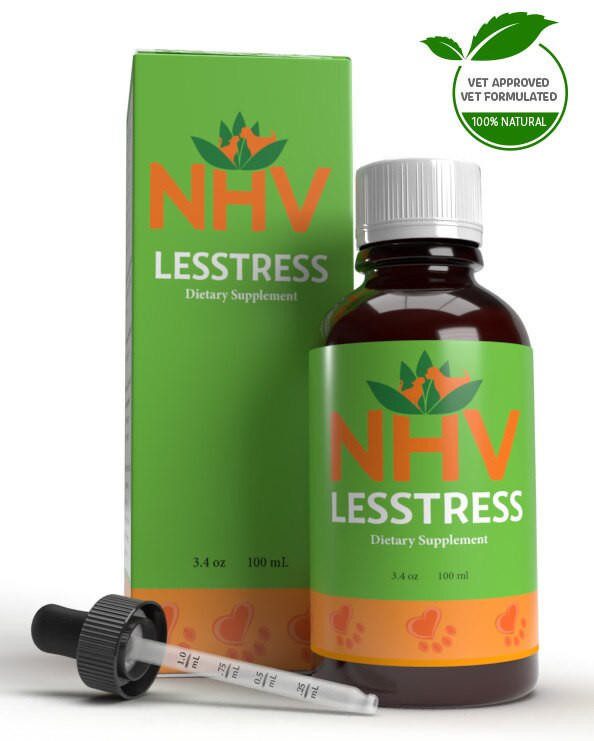
Natural Support for Canine Stress and Anxiety
buy 2 and save $3
3 month supply for a small to medium size pet
Everyone knows what stress feels like, and we all know that too much stress can make us ill—high blood pressure, ulcers and even cancer can result from excessive stress. Like us, dogs can get stressed by numerous factors as well. Help your furkiddo relax into a long and happy life with NHV Lesstress - a natural dog stress support.

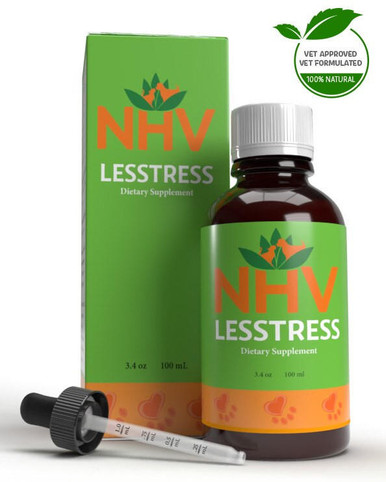
Everyone knows what stress feels like, and we all know that too much stress can make us ill—high blood pressure, ulcers and even cancer can result from excessive stress. Like us, dogs can get stressed by numerous factors as well. Help your furkiddo relax into a long and happy life with NHV Lesstress - a natural dog stress support.

Natural Dog Stress Reliever Supplemental Support
With a heightened sense of hearing and smell, small events that seem mundane to us can be terrifying and stressful for your dogs. Sometimes the stress is from the ride to the office, or maybe they are missing their human companions. This all contributes to changes in behavior like excessive panting, drooling, sweaty paws, dilated eyes, pacing, excessively shedding, or just completely shutting down. Some dogs become so stressed that it may lead to fear and aggression.
Other forms of stress in a dog’s life include:
In addition to panting, excessive barking/whining, chewing on themselves, shivering (when it’s not cold), panicked tail wagging, or tense muscles, stress can also cause GI tract issues such as diarrhea or vomiting.
The key to a healthy pup is balance. Too much or too little activity can be harmful, as well as too much or too little socialization. A balanced, clean diet also helps maintain the body and the mind. If your dog is susceptible to stress, you can use calming herbs like those found in NHV Lesstress. This formulation gently acts on the nervous system and immune system to provide a natural dog stress reliever.
How NHV’s Natural Dog Stress Relief Eases Stress and Anxiety
For stressful experiences such as separation anxiety, the loss or addition of a furry friend, special events (eg. fireworks) and illness (stress can cause conditions to worsen), the natural (non-addictive) sedative properties of Lesstress gently relax the nervous system and endocrine system. Ingredients like Chamomile, Passion Flower and Lemon Balm work to calm nerves while ingredients like Reishi, Eleuthero, and Echinacea Angustifolia are very beneficial for helping the body adapt to stress and illness and stimulate healthy immune function.
Help Support Your Dog Naturally
All NHV supplements like Lesstress are 100% natural and created by a holistic veterinarian and a master herbalist, specially formulated for pets. Feel free to contact our veterinary professionals to get more insight into your little one’s health and wellbeing.
Made with the finest, organically grown, or ethically harvested herbs. Made specifically for pets, vet-formulated and vet approved.
Lesstress for Dogs
Select your pet's weight to determine the correct dose.
To be taken twice daily. Determine your pet’s weight and then use the easy chart below to determine the correct dose. This is the minimum dosage.
Pet's Weight Dosage
0 - 15 lb = 0.5 ml
16 - 30 lb = 1.0 ml
31 - 45 lb = 1.5 ml
46 - 60 lb = 2.0 ml
61 - 75 lb = 2.5 ml
Over 75 lb = 3.0 ml
For small animals (rabbits, ferrets), avians and reptiles use 1 drop for every 2 lb of body weight.
How to Administer
Shake well before use.
The easiest method is to use the dropper provide and places the drops into your pet’s food or favorite treat. You can also use the dropper and squirt directly into the pet’s mouth.
Some pets can be finicky, if this occurs consider hiding the drops in foods most pet’s love such as fish, chicken or yogurt or a favourite treat. If your pet only eats dry food then soak a few kibbles at feeding time.
For Best Results
Herbal dietary supplements are beneficial to the health and wellbeing of your pet and are safe for long-term use. Every pet responds to natural herbal supplements differently, therefore it is important to be consistent and administer the product daily. Supplements generally take two to four weeks to take effect, however this will vary from one animal to the next.
Product Storage
All NHV Natural Pet Products are pure herbal extracts and contain no artificial additives, preservatives or coloring. Shelf life after opening is 6 months and must be refrigerated after opening.
Cautions and Contraindications
Do not use Lesstress in pregnant or nursing animals.
Speak to your vet before using our products. A second visit is recommended if your pet’s condition does not improve, or deteriorates after continued use of the supplements.
All information provided by NHV Natural Pet Products is for educational purposes only.
Natural Dog Stress Reliever Supplemental Support
With a heightened sense of hearing and smell, small events that seem mundane to us can be terrifying and stressful for your dogs. Sometimes the stress is from the ride to the office, or maybe they are missing their human companions. This all contributes to changes in behavior like excessive panting, drooling, sweaty paws, dilated eyes, pacing, excessively shedding, or just completely shutting down. Some dogs become so stressed that it may lead to fear and aggression.
Other forms of stress in a dog’s life include:
In addition to panting, excessive barking/whining, chewing on themselves, shivering (when it’s not cold), panicked tail wagging, or tense muscles, stress can also cause GI tract issues such as diarrhea or vomiting.
The key to a healthy pup is balance. Too much or too little activity can be harmful, as well as too much or too little socialization. A balanced, clean diet also helps maintain the body and the mind. If your dog is susceptible to stress, you can use calming herbs like those found in NHV Lesstress. This formulation gently acts on the nervous system and immune system to provide a natural dog stress reliever.
How NHV’s Natural Dog Stress Relief Eases Stress and Anxiety
For stressful experiences such as separation anxiety, the loss or addition of a furry friend, special events (eg. fireworks) and illness (stress can cause conditions to worsen), the natural (non-addictive) sedative properties of Lesstress gently relax the nervous system and endocrine system. Ingredients like Chamomile, Passion Flower and Lemon Balm work to calm nerves while ingredients like Reishi, Eleuthero, and Echinacea Angustifolia are very beneficial for helping the body adapt to stress and illness and stimulate healthy immune function.
Help Support Your Dog Naturally
All NHV supplements like Lesstress are 100% natural and created by a holistic veterinarian and a master herbalist, specially formulated for pets. Feel free to contact our veterinary professionals to get more insight into your little one’s health and wellbeing.
Made with the finest, organically grown, or ethically harvested herbs. Made specifically for pets, vet-formulated and vet approved.
Lesstress for Dogs
Select your pet's weight to determine the correct dose.
To be taken twice daily. Determine your pet’s weight and then use the easy chart below to determine the correct dose. This is the minimum dosage.
Pet's Weight Dosage
0 - 15 lb = 0.5 ml
16 - 30 lb = 1.0 ml
31 - 45 lb = 1.5 ml
46 - 60 lb = 2.0 ml
61 - 75 lb = 2.5 ml
Over 75 lb = 3.0 ml
For small animals (rabbits, ferrets), avians and reptiles use 1 drop for every 2 lb of body weight.
How to Administer
Shake well before use.
The easiest method is to use the dropper provide and places the drops into your pet’s food or favorite treat. You can also use the dropper and squirt directly into the pet’s mouth.
Some pets can be finicky, if this occurs consider hiding the drops in foods most pet’s love such as fish, chicken or yogurt or a favourite treat. If your pet only eats dry food then soak a few kibbles at feeding time.
For Best Results
Herbal dietary supplements are beneficial to the health and wellbeing of your pet and are safe for long-term use. Every pet responds to natural herbal supplements differently, therefore it is important to be consistent and administer the product daily. Supplements generally take two to four weeks to take effect, however this will vary from one animal to the next.
Product Storage
All NHV Natural Pet Products are pure herbal extracts and contain no artificial additives, preservatives or coloring. Shelf life after opening is 6 months and must be refrigerated after opening.
Cautions and Contraindications
Do not use Lesstress in pregnant or nursing animals.
Speak to your vet before using our products. A second visit is recommended if your pet’s condition does not improve, or deteriorates after continued use of the supplements.
All information provided by NHV Natural Pet Products is for educational purposes only.
multivitamin support
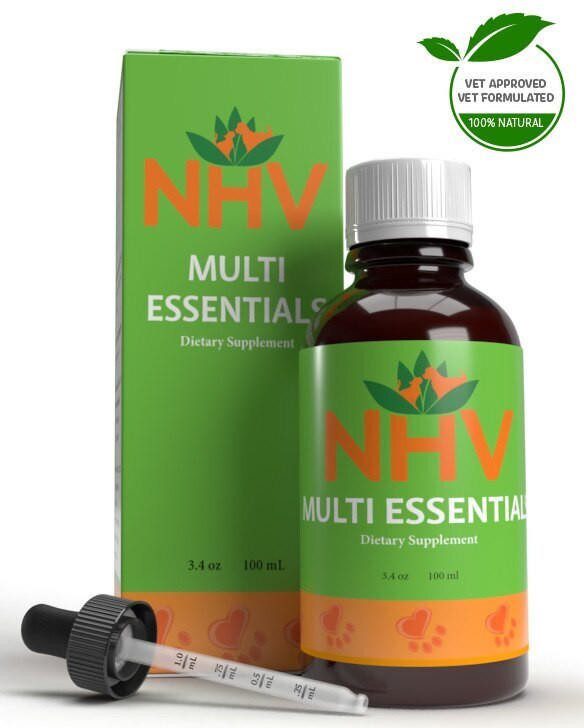
Herbal Digestive Aid, Energy Booster, and Multivitamin for Dogs
buy 2 and save $3
3 month supply for a small to medium size pet
NHV’s multivitamins for dogs targets the brain, stomach, major arteries, kidneys, and liver with a powerful blend of herbal support.


NHV’s multivitamins for dogs targets the brain, stomach, major arteries, kidneys, and liver with a powerful blend of herbal support.

Millions of people take multivitamins daily to support their health, and it only makes sense our canine companions can benefit just as much. This 100% natural plant-based liquid blend can help your dog with nutritional deficiencies.
Signs of Possible Vitamin Deficiency in Dogs
NHV’s Multi-Essentials are packed with herbs that are rich in vitamins and minerals. This vet-formulated blend is designed to benefit your dog’s health using all-natural organically grown herbs with no additives or preservatives.
Even if your pet is healthy, supplying a multivitamin is essential to maintain good health, and some pets need more vitamins and minerals than others. For more, read NHV’s blog, vet talk with Dr. Hillary Cook.
Benefits of NHV’s Multivitamins for Dogs
You can read NHV's blog about the importance of dog vitamin supplements. All pets can benefit from NHV’s Natural Pet Product, even small exotic pets.
If you have questions about plant-based supplements including our multivitamins for dogs, you can schedule a consultation with one of our highly trained holistic veterinarians, because, at NHV, total health and wellness for all pets is our top priority.
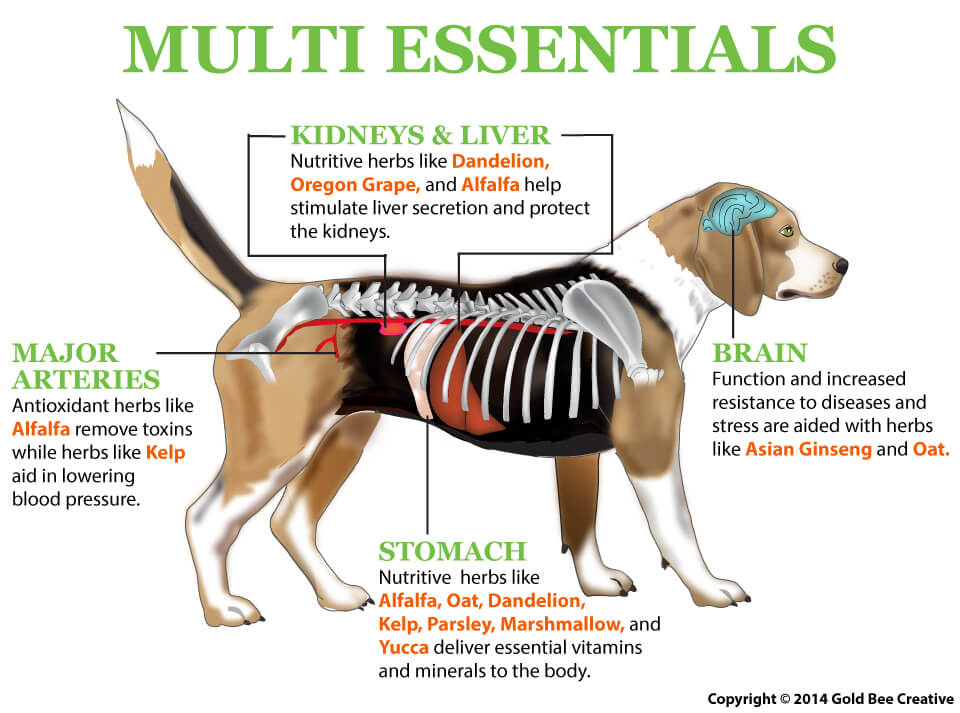
Select your pet's weight to determine the correct dose.
To be taken twice daily. Determine your pet’s weight and then use the easy chart below to determine the correct dose. This is the minimum dosage.
Pet's Weight Dosage
0 - 15 lb = 0.5 ml
16 - 30 lb = 1.0 ml
31 - 45 lb = 1.5 ml
46 - 60 lb = 2.0 ml
61 - 75 lb = 2.5 ml
Over 75 lb = 3.0 ml
How to Administer
Shake well before use. The easiest method is to use the dropper provide and places the drops into your pet’s food or favorite treat. You can also use the dropper and squirt directly into the pet’s mouth.
Some pets can be finicky, if this occurs consider hiding the drops in foods most pet’s love such as fish, chicken or yogurt or a favourite treat. If your pet only eats dry food then soak a few kibbles at feeding time.
For Best Results
Herbal dietary supplements are beneficial to the health and wellbeing of your pet and are safe for long-term use. Every pet responds to natural herbal supplements differently, therefore it is important to be consistent and administer the product daily. Supplements generally take two to four weeks to take effect, however this will vary from one animal to the next.
Product Storage
All NHV Natural Pet Products are pure herbal extracts and contain no artificial additives, preservatives or coloring. Shelf life after opening is 6 months and must be refrigerated after opening.
Cautions and Contraindications
Do not use Multi Essentials in pregnant or nursing animals. Speak to your vet before using our products. A second visit is recommended if your pet’s condition does not improve, or deteriorates after continued use of the supplements.
All information provided by NHV Natural Pet Products is for educational purposes only.
Millions of people take multivitamins daily to support their health, and it only makes sense our canine companions can benefit just as much. This 100% natural plant-based liquid blend can help your dog with nutritional deficiencies.
Signs of Possible Vitamin Deficiency in Dogs
NHV’s Multi-Essentials are packed with herbs that are rich in vitamins and minerals. This vet-formulated blend is designed to benefit your dog’s health using all-natural organically grown herbs with no additives or preservatives.
Even if your pet is healthy, supplying a multivitamin is essential to maintain good health, and some pets need more vitamins and minerals than others. For more, read NHV’s blog, vet talk with Dr. Hillary Cook.
Benefits of NHV’s Multivitamins for Dogs
You can read NHV's blog about the importance of dog vitamin supplements. All pets can benefit from NHV’s Natural Pet Product, even small exotic pets.
If you have questions about plant-based supplements including our multivitamins for dogs, you can schedule a consultation with one of our highly trained holistic veterinarians, because, at NHV, total health and wellness for all pets is our top priority.

Select your pet's weight to determine the correct dose.
To be taken twice daily. Determine your pet’s weight and then use the easy chart below to determine the correct dose. This is the minimum dosage.
Pet's Weight Dosage
0 - 15 lb = 0.5 ml
16 - 30 lb = 1.0 ml
31 - 45 lb = 1.5 ml
46 - 60 lb = 2.0 ml
61 - 75 lb = 2.5 ml
Over 75 lb = 3.0 ml
How to Administer
Shake well before use. The easiest method is to use the dropper provide and places the drops into your pet’s food or favorite treat. You can also use the dropper and squirt directly into the pet’s mouth.
Some pets can be finicky, if this occurs consider hiding the drops in foods most pet’s love such as fish, chicken or yogurt or a favourite treat. If your pet only eats dry food then soak a few kibbles at feeding time.
For Best Results
Herbal dietary supplements are beneficial to the health and wellbeing of your pet and are safe for long-term use. Every pet responds to natural herbal supplements differently, therefore it is important to be consistent and administer the product daily. Supplements generally take two to four weeks to take effect, however this will vary from one animal to the next.
Product Storage
All NHV Natural Pet Products are pure herbal extracts and contain no artificial additives, preservatives or coloring. Shelf life after opening is 6 months and must be refrigerated after opening.
Cautions and Contraindications
Do not use Multi Essentials in pregnant or nursing animals. Speak to your vet before using our products. A second visit is recommended if your pet’s condition does not improve, or deteriorates after continued use of the supplements.
All information provided by NHV Natural Pet Products is for educational purposes only.
Published: November 11, 2024